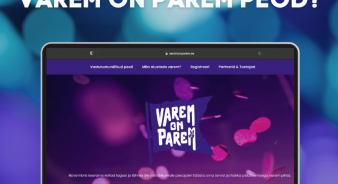


Earlier is Better
Objective
To reduce alcohol abuse and the accompanying harm by changing party culture.
To encourage consumers to visit entertainment venues 1-2 hours earlier than usual.
Description
Establishing the need for the campaign
The “Green Paper on Alcohol Policy”, compiled in 2014 by the Ministry of Social Affairs in collaboration with the private sector and health organisations found that alcohol consumption in Estonia is mainly characterised by drinking for the purpose of becoming intoxicated, and binge drinking is quite common and accepted. This consumption pattern is characterised by a strong link between alcohol consumption and violence. Although the average consumption of alcohol has fallen since the Green Paper, consumption patterns have not changed sufficiently and alcohol consumption for the purpose of intoxication remains widespread.
In addition, entertainment venues are visited at a late hour. It is common to gather with friends at home or at a friend’s place before going out, and for that reason the bulk of the alcohol is consumed before going out. However, the entertainment sector is ready to help change this practice, but individual venues alone are unable to change people’s habits. Artists also often discuss the downsides of giving late performances in the media, but they do not have the power to change the times of their performances.
Also, supervisory authorities associate the entertainment sector with misdemeanours and criminal offences that take place at night, and which, according to the Police and Border Guard Board (PBGB), are mostly committed by people intoxicated by alcohol. According to the PBGB, most of the early morning police responses (3–6 am) are related to what is happening close to entertainment venues. This became clearer when during COVID-19 restrictions, responses of this type became almost non-existent. To describe the problem, the PBGB shared data showing events that required the response of a police patrol in 2019 in Tallinn’s Old Town. The statistics have not changed much over the years although the region has changed (based on where the most popular entertainment establishments are located).
About the campaign
Since the organisation and consumption of entertainment includes multiple interested parties, the successful transformation of social practices requires a new approach at many different levels. The goal is to bring parties together to create a more considerate and well-thought-out way of organising and consuming entertainment.
- Goodwill Agreement: Participating venues and cultural organisers sign the Goodwill Agreement which emphasises that organising entertainment must ensure a high-quality and safe experience. These venues agree to start their programmes at 1-2 hours earlier than usual.
- Reaching consumers: It is crucial to get the message out to people so that they go out earlier (and consequently have less time to consume alcohol at home) so that it becomes the new norm. The message is shared through advertising (online news sites and radio clips), press releases and social media posts. Information materials such as glass coasters, table displays, onsite posters and stickers will also be created.
- Landing page : A landing page lists the participating entertainment venues, explain the campaign’s purpose and need for it.
The campaign was held in November to December 2022 and in June 2023.
Partners
Estonian artists (Andres Puusepp, Hendrik Sal-Saller and Holy Grate).
Estonian entertainment venues (see website).
Results
Results of the 2022 activities:
- On 3 November 2022, the first “Varem on Parem” party was held in the Venus Eesti night club in Tallinn, which started at 7 pm and ended at 11 pm.
- A total of 10 entertainment venues took part in the campaign and 25 events were held earlier.
- 12 posts each on Facebook and Instagram reached 156, 880 and gained 275 followers. They also had 325,973 impressions and 1,099 engagements.
- The www.varemonparem.ee landing page had 2,100-page views.
- Youtube ads reached 329,000 and had 846,000 impressions.
- Google Display reached 211,000 and had 3,574,000 impressions.
- Total output for news website and webpages (Delfie.ee, Delfi and Postimees.ee) was: 6,257,000 impressions, 1,063,000 unique views and 8,534 clicks.
- 6 media sites ran the launch press release and 4 television interviews and 5 radio interviews followed.
Measurement & evaluation
To get a more accurate picture of people’s current habits, a pre-campaign Omnibus survey (1,000 nationally representative respondents) was carried out on 22 September to 14 October 2021. It found that:
- 83% of those aged 18–50 visit entertainment venues at least once a year and 18% visit at least once a month. These results may have been influenced by the COVID-19 restrictions (lockdown in spring and restrictions on non-vaccinated in the autumn).
- 47% often drink alcohol before going out, 92% of which also consume alcohol at the venue.
- Those who drink alcohol at home also consume it at the venue.
- Most people go out between 9pm to 11pm and return home at between midnight and 02 am. There is a clear link between the time of going out and the time of going back home.
A follow-up post-campaign survey was carried out on 25 November to 08 December 2022 (1,015 nationally representative respondents) it found that:
- 87% of those aged 18–50 visit entertainment venues at least once a year and 24% visit at least once a month.
- Consuming alcohol before going out is somewhat decreased (43%), but not the number of people who consume alcohol when out.
- The time range for going to a venue remained the same but there was a slight move to going home earlier.
In addition, from the comments and likes on social media and media articles people liked the campaign. 9% the population of Estonia were reached with the message and artists really liked the idea of the campaign.
Website
https://varemonparem.ee/ Downloads
Downloads
Photo gallery
Documents











